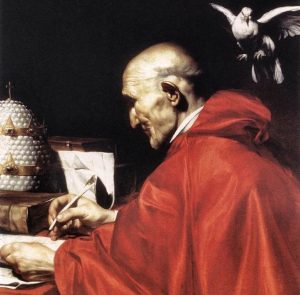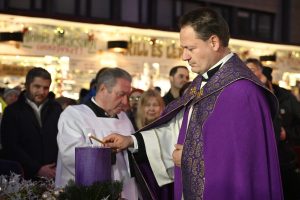
The candy, wrapped in paper and glittering tin foil, is made exclusively by Hungarians.Continue reading

The fourth candle of the Advent wreath, which is lit today, glows with the light of love and stands for St. John the Baptist. On this day, Catholics once again light a purple candle and Protestants a red candle. Advent is a time of reflection and expectation.
In the liturgy, the color of Advent is purple, except on the third Sunday of Advent, when pink is permitted. The word is derived from the Latin adventus Domini, the coming of the Lord.
Originally, only one Advent Sunday was celebrated, but in the 7th century, Pope Gregory the Great fixed the number at four, and in 1570, Pope Pius V made the Advent season mandatory in the Catholic Church. In the past, the Advent season was characterized by the ringing of bells at midnight, strict fasting, and early mass (Rorate).

Pope Gregory the Great, Painting by Jusepe de Ribera (Photo: Wikipedia)
The symbol of Advent is the Advent wreath, which is usually woven from fir branches and on which one of four candles is lit every Sunday. The custom came into fashion in the 19th century, but its roots go back to pagan times. The first Advent wreath, the size of a wagon wheel, still had 24 candles, with one white candle lit every weekday and one red candle lit every Sunday.
The four candles symbolize the light that spreads across the earth through the birth of Jesus, but also faith, hope, love, and joy. The Advent wreaths were blessed in the churches on the first Sunday of Advent or at mass on the Saturday evening before.

Zoltán Kovács, deputy parish priest of St. Stephen’s Basilica, lights the first candle of the Advent wreath at the opening ceremony of the Christmas market in front of St. Stephen’s Basilica (Photo: MTI/Peter Lakatos)
The Advent season is also associated with several folk customs. For example, the sales clerk used to tear off three pieces of bell rope at the first ringing of the morning mass, which she then wore in her hair so that she would have many visitors at carnival. In Transylvania (Romania), doors and windows were kept closed during the morning mass to prevent the witches, who took the form of animals, from entering houses and barns. In the Great Hungarian Plain (Alföld), girls ate honey or sugar when the bells rung at dawn to sweeten their tongues and thus “sweeten” their husbands.
On December 4, St. Barbara’s Day, girls would break off a branch of cherry or lilac (Barbara’s branch), place it in water, and if it blossomed, it meant that they would soon be married. On December 13, Lucia Day (the shortest day of the year before the calendar reform), girls wrote the names of boys on 13 pieces of paper and threw one into the fire each day: at Christmas, the remaining piece of paper would tell them who their husband would be.

The mystery of Christmas – Advent calendar based on the church year from the first Advent to Epiphany by Paula Jordan. (Photo: Wikipedia)
The original purpose of the Advent calendar was to get adults and children in the mood for Christmas (the first printed Advent calendar was produced in Munich in 1908). Behind each window of the “real” calendar is a thought about the Christmas cycle. Today, this religious content has faded into the background; industry and commerce have transformed it into a December calendar, with chocolate or marzipan behind each door.
The circle of light closes on the fourth Sunday of Advent and all four candles of the Advent wreath light up the world.
For this light goes beyond itself: it represents the Son of God. In the Gospel of John 8:12, Jesus says about himself: “I am the light of the world. Whoever follows me will not wander in darkness, but will have the light that leads to life.”

A candle is lit on the Advent wreath on Mátyás Square in front of the Franciscan church in Szeged (Photo: MTI/Peter Lehoczky)
The fourth Advent candle also points to something else. It reminds us of the pure glow of the star that led the wise men of the dawn to Bethlehem and of the greatest prophet of the time before the public appearance of Jesus, the messenger of the Lord, John the Baptist, who announced the imminent arrival of the Messiah as a “cry in the wilderness.”
John the Baptist was a close relative of Jesus. According to the evangelist Matthew (Mt 11:11), Jesus once said: “Truly I tell you, among the children of women there has not been born a greater than John the Baptist.”
The Protestant tradition associates a different idea with the fourth Advent candle, as it stands for the bridge of peace and love that was built between God and mankind with the birth of the Savior. They therefore think of the second divine person, Jesus, when they light the fourth candle.

Photo: Facebook/Orbán Viktor
Ottokár Prohászka, the 15th Bishop of Székesfehérvár, taught in this context: “In Advent we put pear blossoms in the water, and they blossom, and man rejoices, rejoices in the mystery of life and the unfolding of beauty.
Should not our soul also be such a branch that blossoms into new life through the longing of Advent and breathes out its love and devotion in beauty and purity of heart to its Savior?”
It is our duty, and not a little of it, not only during Advent, but also on other days of the year, to follow the path marked by the bright shining of the Star of Bethlehem.
via hirado.hu, mult-kor.hu, Featured Image: Facebook/Orbán Viktor